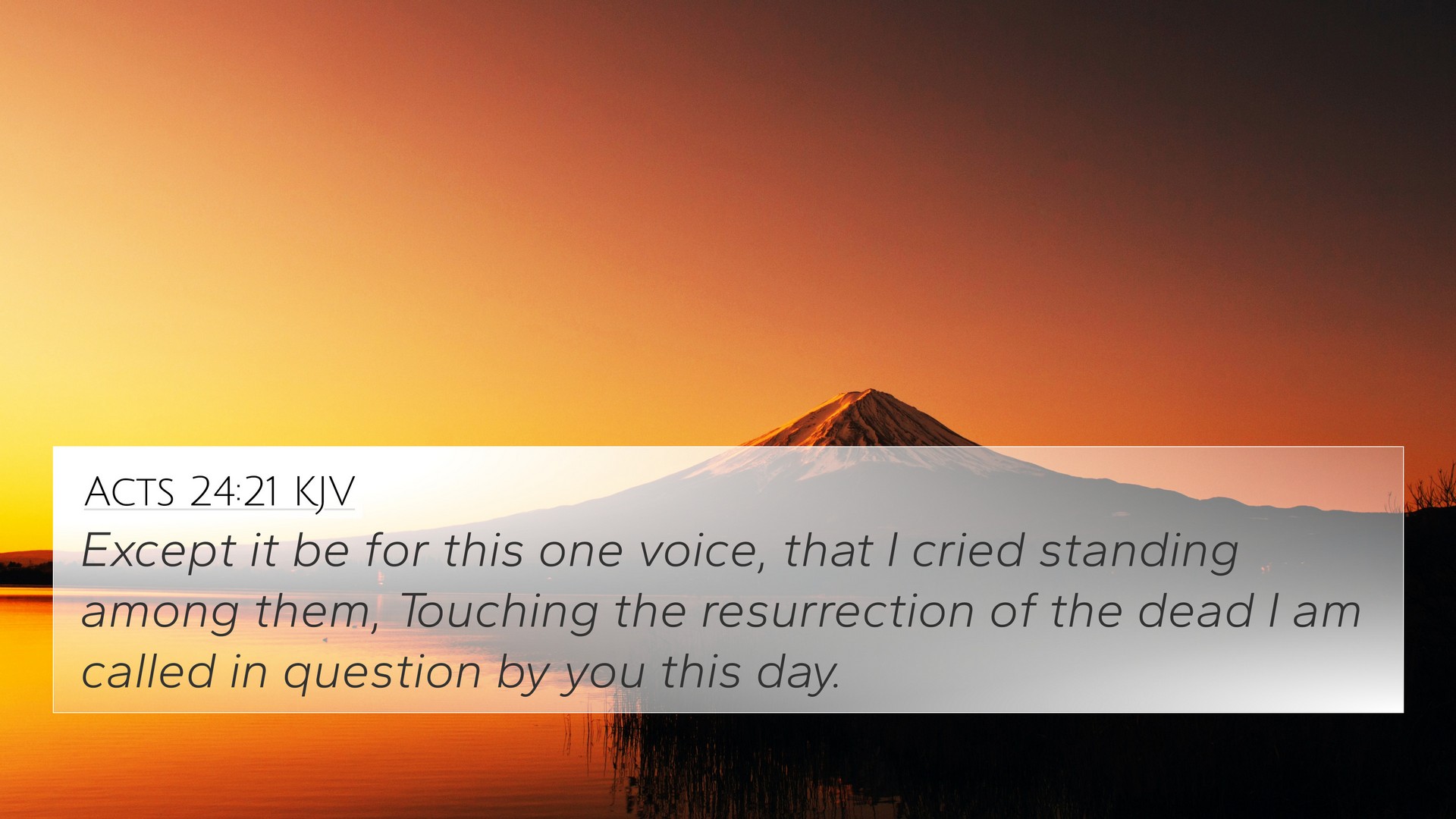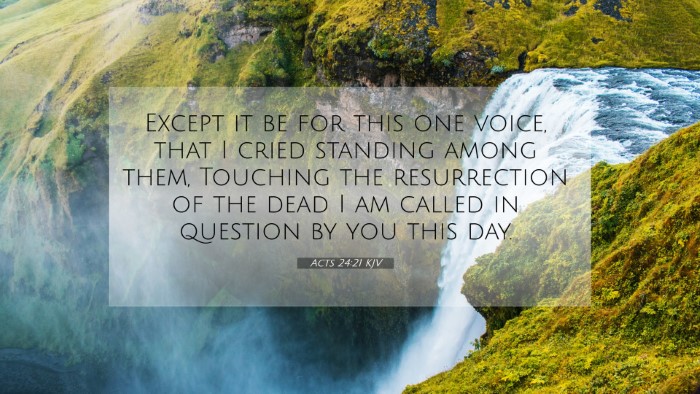Old Testament
Genesis Exodus Leviticus Numbers Deuteronomy Joshua Judges Ruth 1 Samuel 2 Samuel 1 Kings 2 Kings 1 Chronicles 2 Chronicles Ezra Nehemiah Esther Job Psalms Proverbs Ecclesiastes Song of Solomon Isaiah Jeremiah Lamentations Ezekiel Daniel Hosea Joel Amos Obadiah Jonah Micah Nahum Habakkuk Zephaniah Haggai Zechariah MalachiActs 24:21 Similar Verses
Acts 24:21 Cross References
Except it be for this one voice, that I cried standing among them, Touching the resurrection of the dead I am called in question by you this day.
Uncover the Rich Themes and Topics of This Bible Verse
Listed below are the Bible themes associated with Acts 24:21. We invite you to explore each theme to gain deeper insights into the Scriptures.
Acts 24:21 Cross Reference Verses
This section features a detailed cross-reference designed to enrich your understanding of the Scriptures. Below, you will find carefully selected verses that echo the themes and teachings related to Acts 24:21 KJV. Click on any image to explore detailed analyses of related Bible verses and uncover deeper theological insights.
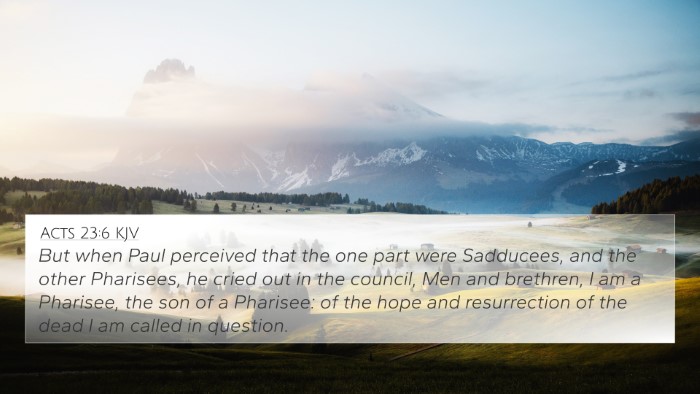
Acts 23:6 (KJV) »
But when Paul perceived that the one part were Sadducees, and the other Pharisees, he cried out in the council, Men and brethren, I am a Pharisee, the son of a Pharisee: of the hope and resurrection of the dead I am called in question.
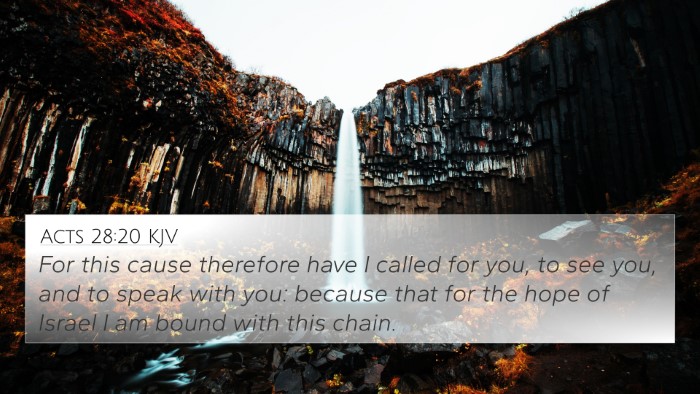
Acts 28:20 (KJV) »
For this cause therefore have I called for you, to see you, and to speak with you: because that for the hope of Israel I am bound with this chain.
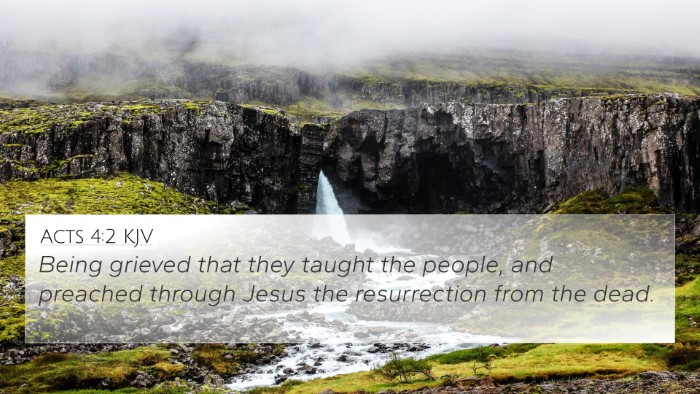
Acts 4:2 (KJV) »
Being grieved that they taught the people, and preached through Jesus the resurrection from the dead.
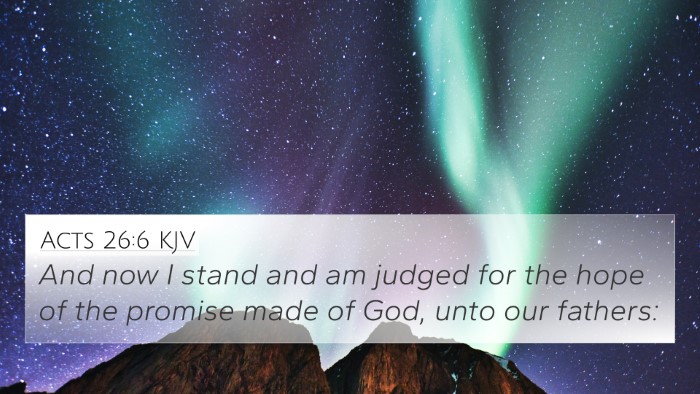
Acts 26:6 (KJV) »
And now I stand and am judged for the hope of the promise made of God, unto our fathers:
Acts 24:21 Verse Analysis and Similar Verses
Understanding Acts 24:21
In Acts 24:21, the Apostle Paul asserts, “Unless it is for this one thing that I cried out, standing among them, ‘Concerning the resurrection of the dead I am being judged by you this day.’” This statement occurs during Paul's trial before Felix, illustrating a critical moment in his defense against accusations from the Jewish leaders.
Summary of Commentary Insights
- Matthew Henry: Henry emphasizes that Paul's declaration centers around the resurrection, a pivotal doctrine of the Christian faith. Paul skillfully redirects the focus of his trial from the accusations against his character to the core of his belief, highlighting how the resurrection serves as a divisive issue between the Pharisees and Sadducees.
- Albert Barnes: Barnes notes that Paul’s argument was a strategic maneuver to showcase that the real conflict was theological rather than legal. The resurrection is portrayed as the foundation of hope and a significant point of contention in Jewish belief that could potentially win sympathy for Paul among some of his judges.
- Adam Clarke: Clarke points out that Paul’s statement reveals his unwavering commitment to the truth of the Gospel. He articulates that the resurrection signifies both Christ’s victory over death and the future hope of believers, thus framing his trial as part of a larger spiritual battle.
Thematic Connections
Acts 24:21 opens up several thematic connections and cross-references with other Bible verses:
- Acts 4:2: "They were greatly annoyed because they were teaching the people and proclaiming in Jesus the resurrection from the dead." This verse connects to Paul’s emphasis on the resurrection as a central theme in the early church’s teaching.
- Acts 17:18: "Some of the Epicurean and Stoic philosophers also conversed with him. And some said, 'What does this babbler wish to say?' Others said, 'He seems to be a preacher of foreign divinities'—because he was preaching Jesus and the resurrection." Here, we find further illustration of how the resurrection provoked varied reactions among different groups.
- 1 Corinthians 15:12-14: "Now if Christ is proclaimed as raised from the dead, how can some of you say that there is no resurrection of the dead? But if there is no resurrection of the dead, then not even Christ has been raised." Paul elaborates on the foundational importance of the resurrection, reinforcing its significance in his defense.
- Philippians 3:10-11: "That I may know him and the power of his resurrection, and may share his sufferings, becoming like him in his death, that by any means possible I may attain the resurrection from the dead." This illustrates Paul's personal connection and commitment to the resurrection, providing insight into his motivation and hope.
- John 11:25-26: "Jesus said to her, 'I am the resurrection and the life. Whoever believes in me, though he die, yet shall he live, and everyone who lives and believes in me shall never die.'" Jesus’ claim underlines the very essence of the resurrection as a life-giving force in the faith.
- Romans 6:4: "We were therefore buried with him through baptism into death in order that, just as Christ was raised from the dead through the glory of the Father, we too may live a new life." This verse links baptism to the resurrection and encourages believers in their new identity in Christ.
- 2 Timothy 2:8: "Remember Jesus Christ, risen from the dead, the offspring of David, as preached in my gospel." This passage shows Paul's commitment to the resurrection as part of his preaching and mission.
Conclusion
In summary, Acts 24:21 serves not only as a defense of Paul's beliefs but also as a profound assertion of one of the central tenets of Christianity—the resurrection. Through the lens of historical context and scriptural parallels, we come to understand the weight of this claim in the early church and its implications for believers today.
Utilizing tools for Bible cross-referencing can enhance our understanding of such verses and their connections. By identifying connections between the Old and New Testament, we can build a more cohesive narrative of God’s redemptive plan and the life-transforming power of the resurrection.
